INTRODUCTION
- All cells reproduce by dividing into two, with each parental cell giving rise to two daughter cells each time they divide.
- Growth and reproduction are characteristics of cells, indeed of all living organisms.
- Such cycles of growth and division allows single cell to form a structure consisting of millions of cells
CELL CYCLE
- It is sequence of events by which a cell duplication its genome, synthesises the other constituents of the cell and eventually divides into two daughter cells.
- Cell growth results in disturbing the ratio between the nucleus and cytoplasm. It is therefore becomes essential for the cell to divide to restore the nucleo-cytoplasmic ratio.
- Cell growth (in terms of cytoplasmic increase) is a continous process.
- Duration of cell cycle can vary from organism to organism and also from cell type to cell type.
e.g. Yeast-cell cycle duration-90 minutes.
Human cell cycle duration- 24 hours but cell division proper lasts for only about an hour.
PHASES OF CELL CYCLE
- Called resting phase
- Cell is preparing for division by undergoing both cell growth and DNA replication in an orderly manner.
- It lasts more than 95% of the duration of cell cycle.
2. M-Phase:-
- Actual cell division phase.
- Starts with nuclear division(karyokinesis) nad usually ends with division of cytoplasm (cytokinesis).
INTERPHASE
- Divided further into three phases:-
(i) G1 phase (Gap1)
(ii) S phase (Synthesis)
(iii) G2 phase (Gap2)
- Some cell s do not divide further, exit G1, phase to enter an inactive stage called quiescent stage (G0) of the cell cycle.
- Cell in this stage remain metabolically active but no longer proliferate unless called on to do so depending on the requirement of the organism eg. Heart cells.
- Interval between mitosis and initiation of DNA replication.
- Cell is metabolically active and continuously grows but does not replicate its DNA.
- Most of the cell organelles duplicate.
- This phase marks the phase of DNA replication and chromosome duplication.
- Amount of DNA per cell doubles but there is no increase in intial chromosome number
- In animal cells, centriole duplicates in cytoplasm.
- DNA replication begins in necleus.
- Proteins are synthesised in preparation for mitosis while cell growth continues
Note:- In animal cells mitotic division is only seen in diploid somatic cells. Plant cells show mitotic division in both haploid and diploid cells.
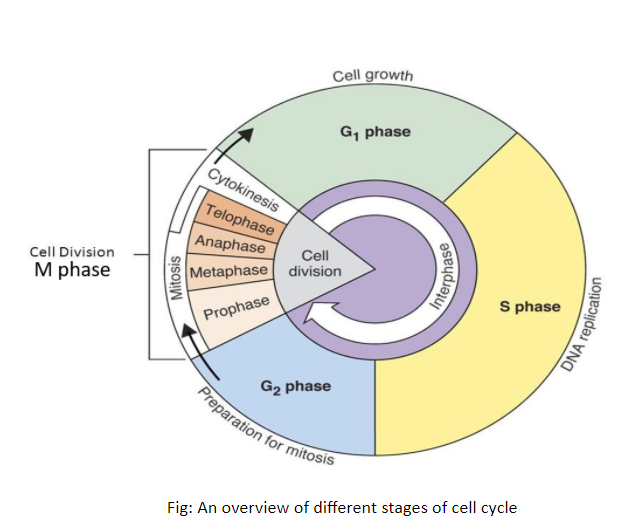
M PHASE (MITOSIS)
- Most dramatic period of cell cycle.
- Chromosome number in parent and progeny cells is the same hencecelled equational division.
Divided into:-
- KARYOKINESIS
- CYTOKINESIS
KARYOKINESIS
(i) PROPHASE:-
- Prophase, follows the S and G2 phases of interphase.
- Marked by the initiation of condensation of chromosomal matarial which becomes untangled.
- Centrosome starts to move towards opposite poles.
- The completion of prophase can be marked by-
(a) Chromosome condense to form compact mitotic chromosome.
(b) Each centrosome reach at reach at pole and radiates out microtubules called asters. The two asters together with spindle fibres form mitotic apparatus.
- At the end of prophase cells do not show Golgi complex, ER nucleous and nuclear envelop.
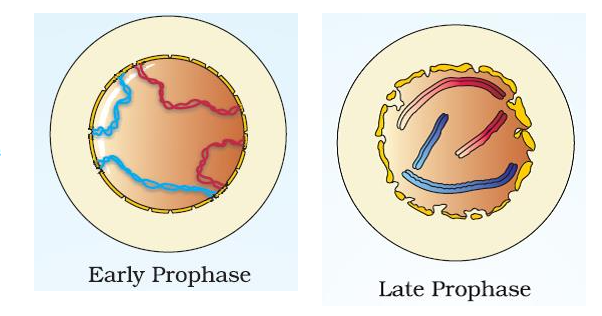
Lorem ipsum dolor sit amet, consectetur adipiscing elit. Ut elit tellus, luctus nec ullamcorper mattis, pulvinar dapibus leo.
(II) METAPHASE:-
- The complete disintegration of the nuclear envelop marks the start of metaphase.
- Condensation of chromosomes is completed and can be onserved clearly under microscope and morphology of chromosome is most easily studied.
- Each chromosome has two sister chromatids which are held together by the centromere.
- All the chromosome coming to lie at equator.
- Each chromosome connected by its kinetochore to spindle fibre from one and its sister chromatid connected by its kinetochore to spindle fibre the opposite pole.
- The plane of alignment of the chromosomes at metaphase plate.
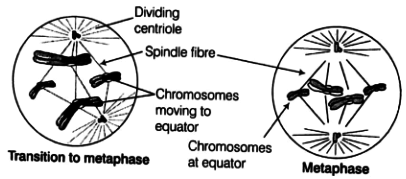
(iii) ANAPHASE:-
- Centromere of each chromosome split simultaneously and chromatids separate.
- Two daughter chromatids, nowreferred to as daughter chromosome begin their migration towards the opposite poles.
- The centromere of each chromosome remain directed towards the pole and arms trailing behind (leading to different shapes of chromosomes)
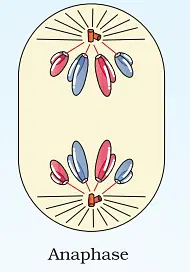
(iv) TELOPHASE:-
- Final stage of karyokinesis.
- Chromosomes that have reached their respective poles decondense and lose their individuality.
- Nuclear envelop develops around the chromosome cluster at each pole forming two daughter nuclei.
- Nucleolus, Golgi complex and ER reform.
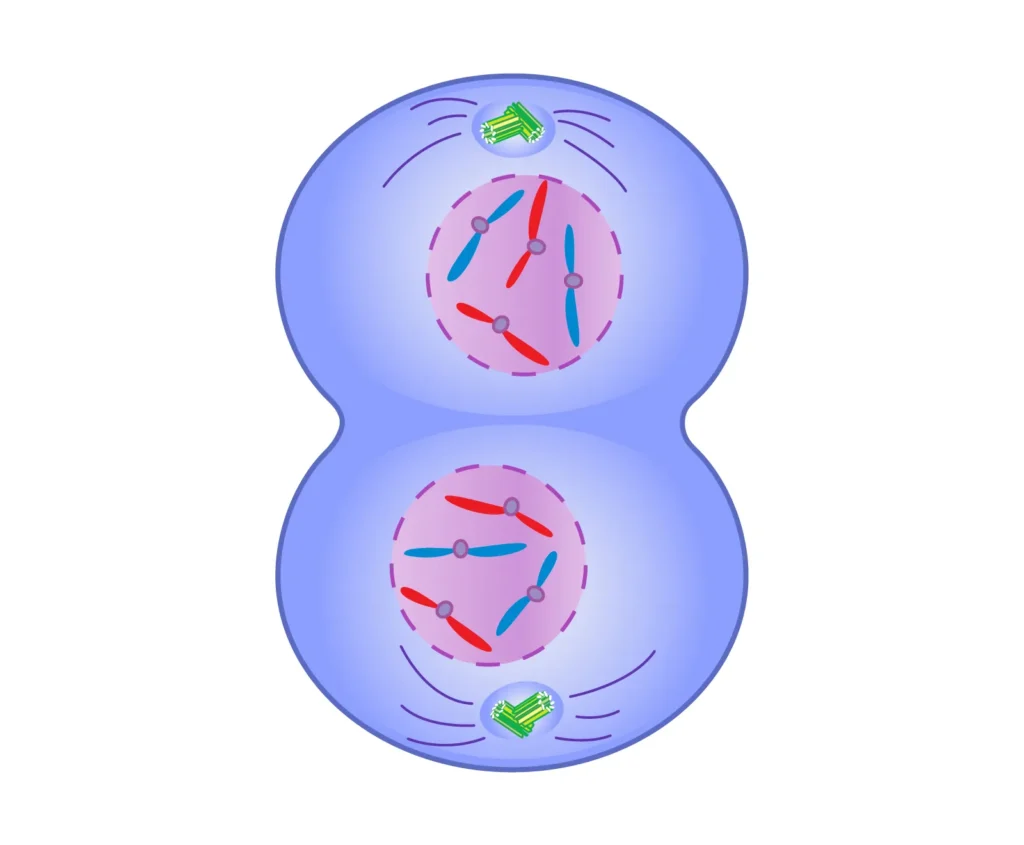
2. CYTOKINESES:-
- It is division of cytoplasm at the end of which cell division gets completed.
- In animals cells it is achieved by the appearance of a furrow in the plasma membrane.
- In plant cells cytokineses is achieved by wall formation, which starts in the center of the cell and grows outward to meet the existing lateral wall.
- The formation of new cell wall begins with the formation, of the simple precursor, called the cell plate that represent the middle lamella between the wall of twp adjacent cells.
- When karyokinesis is not followed by cytokineses as a result of which multi nucleate condition arises leading to formation of syncytium leading to formation of syncytium e.g., liquid endosperm in coconut.
- Mitosis usually in identical genetic complement in daughter cells
- Growth of multicellular organsims
- Cell repair
- Mitotic division in apical and lateral meristem results continuous growth of plants throughout their life.
- In some lower plants and in some insects haploid cell also divide by mitosis.
- Specialised kind of cell division that reduces the chromosome by half results in the production of haploid daughter cells.
- Meiosis ensures the produces of haploid phase in the life cycle of sexually reproducing organisms whereas fertilization restores the diploid phase.
- Meiosis involves two sequential cycles of nuclear division i.e. meiosis I and meisosis II but only single cycle of DNA replication.
- Four haploid cells are formed at the end of meiosis II.
MEIOSIS I (Reductional phase)
Prophase I
- Typically longer and more complex when compared to prophase of mitosis
- Leptotene
- Chromosomes becomes gradually visible under the light microscope.
- The complication of chromosomes continues throughout leptotene.
2. Zygotene
- Homologous chromosomes called synapsis.
- Synapsis is accompanied by formation of complex structure called synaptonemal complex.
- The complex formed by a pair of synapsed homologous chromosomes is called bivalent or a tetrad
- Leptotene and zygotene are relatively short lived compared to the pachytene.
3. Pachytene
- Four chromatids of each bivalent become distinct and clearly appears as tetrads.
- Appearance of recombination nodule, the sites at which crossing over occurs between non- sister chromatids of the homologous chromosomes.
- Crossing over is exchange of genetic material between two homologous chromosomes. It is an enzyme mediated process, enzyme involved is called recombinase.
- Crossing over leads to recombination of genetic material which is completed by the end of pachytene leaving chromosomes linked at the sites of crossing over.
4. Diplotene
- Beginning of diplotene is recognised by the dissolution of synaptonemal complex and tendency of the recombined homologous chromsomes of the bivalent to separates from each other except at the sites of crossovers.
- This X- shaped structures (site of crossing over) are called chiasmata.
- In oocytes of some vertebrates, diplotene can last for months or years (dictyotene).
5. Diakinesis
- This is marked by terminalisation of chiamata
- Chromosomes are fully condensed and meiotic spindle is assembled to prepare the homologous chromoosomes for seperation
- By the end of diakinesis, the nucleolus disappears and nuclear enelope also break down.
- Diakinesis represents transition to metaphase.
METAPHASE I
- Bivalent chromosomes align on the equatorial plate (double metaphasis plate)
- Micro tubules from the oppoosite poles of the spindle attach to the kinetochore of homologous chromosomes
ANAPHASE I
- Homologous chromosomes seperates, while sister chromatids remain associated at their centromere.
TELOPHASE I
- The nuclear membrane and nucleolus reappear
- Cytokinesis follows and this is called as dyad of cells.
- It is the stage between two meiotic divisions.
- It is generally short lived.
- No DNA replication
- It is followed by prophase II.
MEIOSIS II- (Equational phase)- Resembles a normal mitosis
PROPHASE II
- It is initiated immediatly after cytokinesis
- The nuclear membrane disappears by the end of prophase II
- Chromosomes become compact.
METAPHASE II
- Chromosomes align at the equator
- Microtubules from opposite poles of the spindle get attached to the kinetochore of sister chromatids
ANAPHASE II
- Splitting of centromere allowing chromsomes to move towards opposite poles of the cells by shortening of microtubules attached to the kinetochores.
TELOPHASE II
- Meiosis ends with telophase II
- Two groups of chromosomes once agian get enclosed by a nuclear envelope
- Cytokinesis follow resulting in the formation of tetrad of cells.
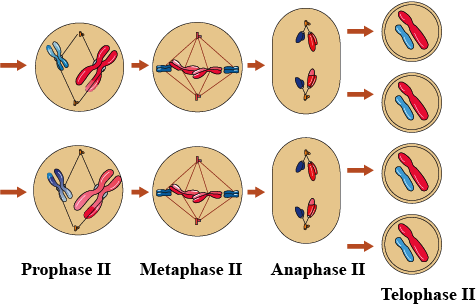
Significance of meiosis
- Conservation of specific chromosome number pof each species is achieved across generation in sexually reproducing organism, paradoxically results in reduction of chromosome number by half.
- Increases genetic variability in the population of organisms which is important for the process of evolution.
FUNFACT-
Within the human body, approximately 25 million new cells are produced each second through the process of cell division, ensuring continuous growth and renewal.
During cell division, the DNA in a human cell—approximately 2 meters long when fully stretched—is carefully packaged into compact structures called chromosomes to ensure accurate distribution to daughter cells.
While most cells in the human body undergo cell division, certain specialized cells, such as nerve cells and muscle cells, remain in a non-dividing state called G0 phase for extended periods, or even for the entire lifespan of an organism.
The cell cycle is highly regulated by a series of molecular checkpoints, akin to “traffic lights,” which monitor the cell’s readiness to progress through each phase of the cycle and ensure proper DNA replication and chromosome segregation.
Cancer, characterized by uncontrolled cell growth and division, often arises from mutations in genes that control the cell cycle, leading to the disruption of checkpoint mechanisms and aberrant cell proliferation.
In plants, cell division occurs not only in meristematic regions (areas of active growth) but also in differentiated tissues, allowing for continuous growth and repair throughout the plant’s life.
Some single-celled organisms, such as bacteria and yeast, reproduce through binary fission, a simpler form of cell division in which a parent cell divides into two genetically identical daughter cells.
During mitosis, the process of nuclear division, the cell’s genetic material is meticulously partitioned into two daughter nuclei, ensuring that each new cell receives an exact copy of the parental genome.
In certain organisms, such as amphibians and starfish, cell division can occur rapidly and synchronously during regeneration processes, allowing for the rapid replacement of lost or damaged tissues.
The study of the cell cycle and cell division has profound implications beyond biology, influencing fields such as medicine, biotechnology, and agriculture, where insights into cellular processes are harnessed for therapeutic interventions, genetic engineering, and crop improvement strategies.
FAQ”s
The cell cycle is the series of events that occur in a cell as it prepares for and undergoes division. It consists of interphase (G1, S, and G2 phases) and mitotic (M) phase.
Interphase is the longest phase of the cell cycle. During interphase, the cell grows, duplicates its DNA, and prepares for cell division. It consists of three sub-phases: G1 (gap 1), S (synthesis), and G2 (gap 2).
DNA replication occurs during the S phase of interphase. It ensures that each daughter cell receives a complete set of genetic material (chromosomes) during cell division.
The mitotic phase, also known as M phase, is the phase of the cell cycle during which cell division occurs. It consists of mitosis (nuclear division) and cytokinesis (cytoplasmic division).
Mitosis consists of several stages: prophase, prometaphase, metaphase, anaphase, and telophase. During these stages, the duplicated chromosomes condense, align at the metaphase plate, separate into daughter cells, and decondense into chromatin.
It is very fruitful.And waiting for next post..
Hi there! Just wanted to let you know how much I enjoyed reading this post. Your approach to the subject was unique and informative. It’s clear that you put a lot of effort into your writing. Keep up the great work, and I can’t wait to see what else you have in store.